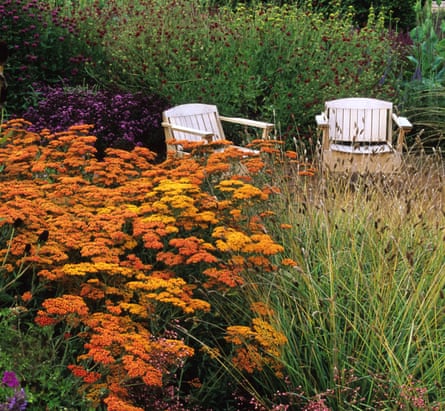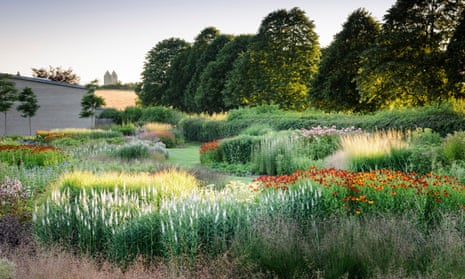Piet Oudolf’s landscapes are as peopled as they are planted. Folks flock to them, whether it’s the High Line in New York, the meadows at Hauser & Wirth’s art gallery in Somerset, or the Olympic Park in Stratford, to name a few. Many of his gardens may be in hip locations or attached to big-name architects, but the reason people return again and again is his planting. His designs offer up something wild and alive. The plant combinations are dynamic and playful: you are as likely to go and admire decaying seed heads in winter as you are spring blossom. They rip up the flowerbed rule book and roll out, often over vast spaces. “I like to escape some of the rules around gardening – to provide thought and spontaneity, and pleasure.”
The Guardian’s product and service reviews are independent and are in no way influenced by any advertiser or commercial initiative. We will earn a commission from the retailer if you buy something through an affiliate link. Learn more.
In many ways, he needs little introduction: there are Oudolf meadows up and down the country, from Scampston Hall and RHS Wisley to Trentham Gardens, all showcasing his complex, highly naturalistic schemes. Some of his earliest work can be found in public parks in Sweden and the Lurie Garden in Chicago. Next month, Oudolf will be exhibiting at the Royal Horticultural Society’s Hampton Court flower show, where he is creating a walk-through feature – complete with favourites astilbe, schizachyrium and monarda – and receiving the inaugural RHS Horticultural Heroes accolade. “England was the first country to appreciate my work and my approach to gardening,” he says.

His naturalistic, perennial meadow style exerts such an influence that you now see it in local pocket parks, on roundabouts and in amenity schemes all over the place. Not long ago, the dominant amenity planting style was seasonal bedding, petunias, pelargoniums and pansies – brightly coloured, but sterile, devoid of wildlife and lacking spontaneity.
The New Perennial Movement, of which Oudolf is often seen as the figurehead, changed all that, with herbaceous plantings and meadows made up of robust perennials and grasses. “Every time I do a private job, I think, ‘This is beautiful and great, but who is going to see it? Two people and their guests.’ My only interest is sharing my work with lots of people,” he says.

He uses a sophisticated palette of plants that are chosen for the rhythm they create over the seasons; they have to look as good in decay as they do in the first unfurling of spring. If eupatoriums and sanguisorba feel mainstream, it’s because Oudolf introduced them to a wider audience. He has even bred his own strains including Gaura lindheimeri ‘Whirling Butterflies’ and Salvia verticillata ‘Purple Rain’. This makes for a landscape that you need to return to again and again to see how this gyrating descent and retreat of shades, textures and hues shifts over the seasons. If his gardens look breathtaking at the height of summer, by autumn and winter they are often heart-rending, as the yellows, purples and reds fade touchingly to subtler shades of brown, tan, blond and eventually black. There’s something emotional about these landscapes.
In the 1980s, Oudolf, along with his wife, Anja, started a nursery to support Piet’s design studio at their home in Hummelo, a tiny village in the eastern part of the Netherlands. Here they experimented with a wide range of perennials, looking for robustness, but also beauty in decay, how a plant looks before and after flowering, whether their seed heads withstood winter, what sort of management they would need, and how they would compete with their bedfellows. Garden enthusiasts and designers from around the world flocked to buy plants and see his naturalistic plant combinations at work. “In our first catalogue, there were plants that people had always thought of as wild – and we were selling them,” he says. “They may have been wild, but they were also attractive and well-behaved.” Now in his 70s, Oudolf shows no sign of slowing down. He’s even tackling food-growing, creating an edible meadow around Noma’s new restaurant in Denmark. “It’s an adventure,” he says. “We’ve sown a crop of barley and put some edibles in between. We’re just finding our way – next year it’s going to be much more bold.”

When I think of Oudolf’s work, I think about the parallels it has with those medieval Dutch flowering paintings that reminded the viewer of the fragility of life – including the odd worm, moth, torn or fallen petal. Even the most beautiful of flowers is to be pollinated, and will eventually rot. Oudolf’s love of seed heads and wind-dried winter stems is a similar reminder, often of the transience of such earthly pleasure.
The RHS Hampton Court Palace flower show runs 3-8 July (rhs.org.uk)
How to get the Oudolf look
Sanguisorba canadensis A robust plant with white cylindrical flower heads that appear in late summer. Classic Oudolf.
Calamagrostis x acutiflora ‘Karl Foerster’ In Oudolf’s words, ‘indispensable for the winter garden’.
Molinia caerulea ‘Purple Moor Grass’ Fits in anywhere; slim, transparent and will pull a whole scheme together as long as you plant enough.
Thalictrum flavum subsp glaucum Forms huge clumps of waxy blue-grey foliage and clusters of yellow flowers; it does like to flop, though. Steal an Oudolf trick and grow it behind a shrub it can drape itself over.
Cephalaria gigantea A huge plant, not really for a small garden, though it could be used in, say, a front garden as a stand alone. It has pale yellow scabious flowering on lightly branched stem and grows to 2.5m tall.
Eupatorium purpureum subsp maculatum ‘Atropurpureum’ Gigantic purple-pink umbels on red stems, loved by late summer butterflies. Grows up to 2.5m tall.

Comments (…)
Sign in or create your Guardian account to join the discussion